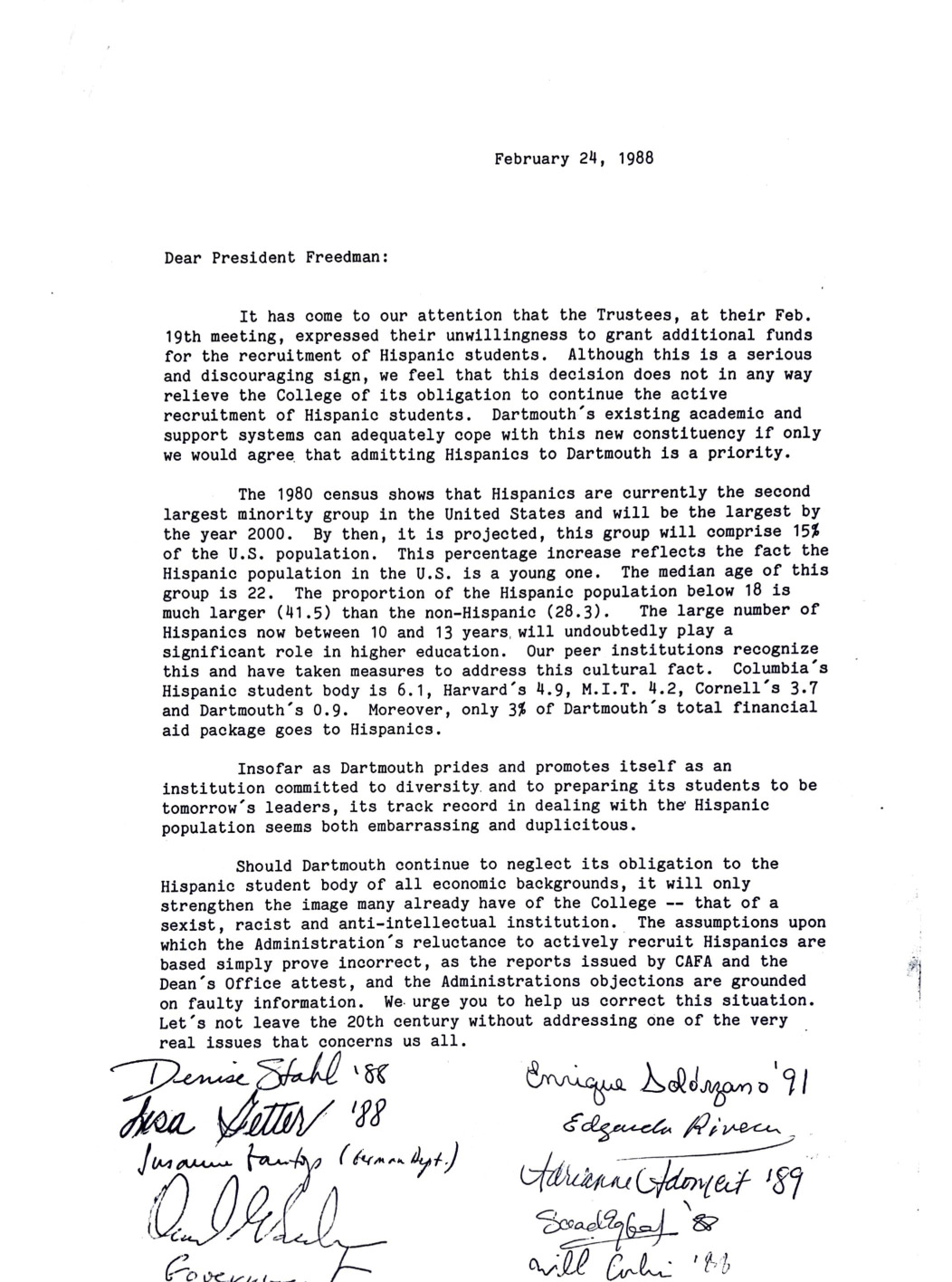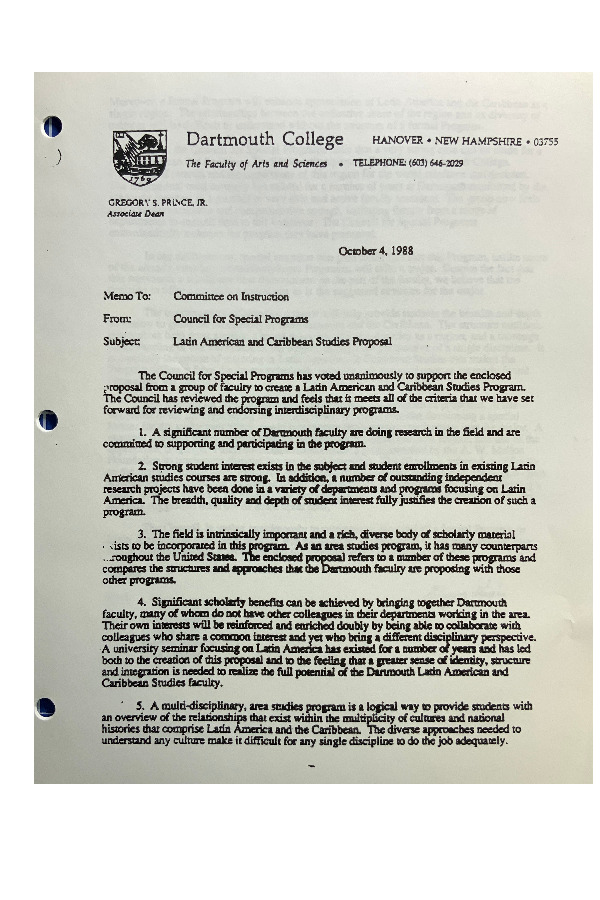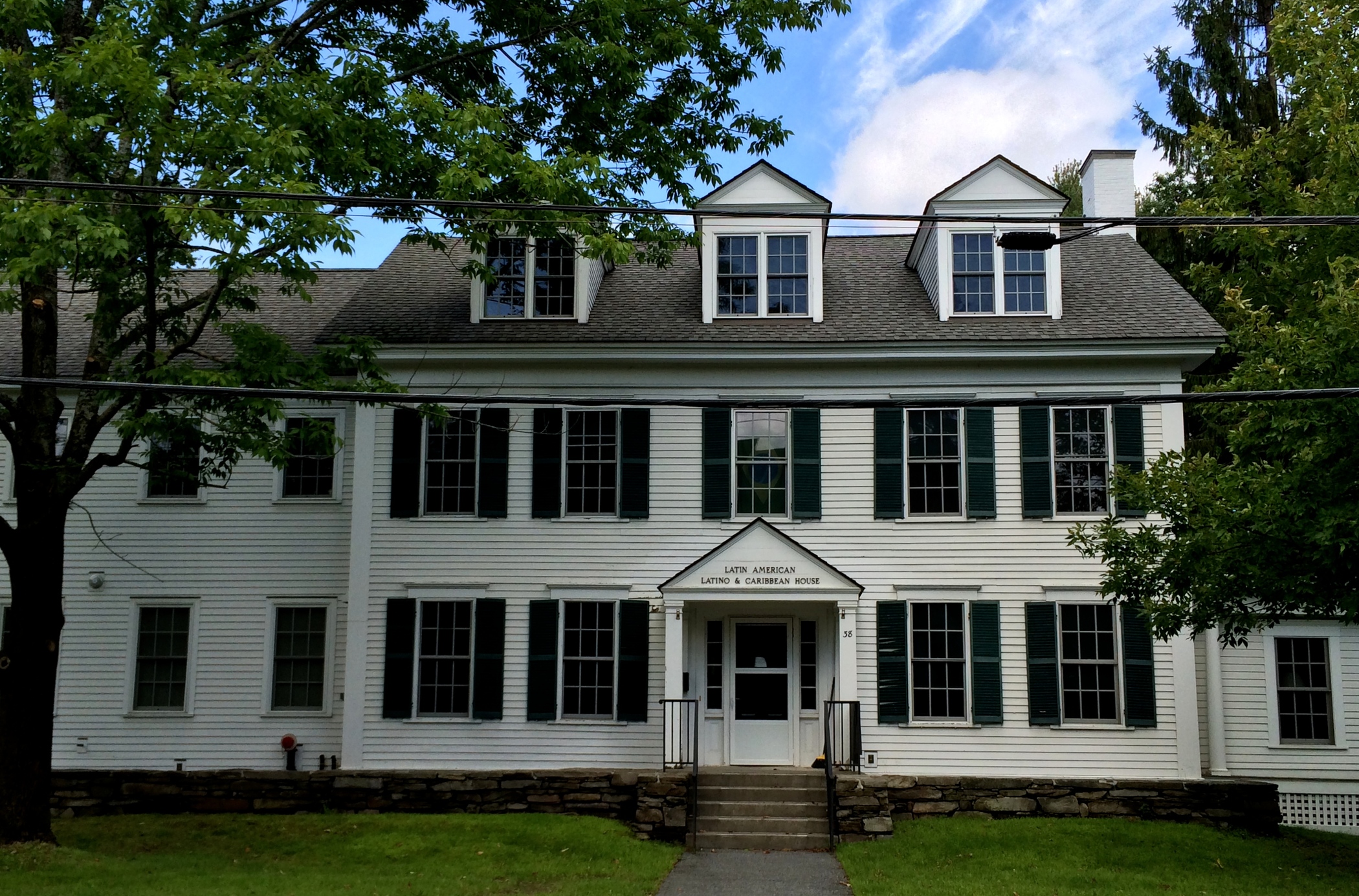Early Efforts to Help Latinx Students at Dartmouth Succeed
By Nicholas Romans '24.
In this exhibit, I will discuss early struggles faced by Latinx students at Dartmouth. First, Latinx struggles as well as Dartmouth's response to these struggles, will be contextualized through an analysis of various primary sources. This will be followed by an analysis of the creation of the LALACS (Latin American and Carribean Studies) department, as well as a discussion of its early efficacy. Finally, there will be a discussion of student Latinx organizations which will show Dartmouth Latinx students took matters into their own hands.
Early issues facing the Latinx community at Dartmouth
In a letter written in 1988, (shown on the left) students as well as staff implore the Dartmouth president at the time, President Freedman, to increase funding for Latinx students on campus as well as Latinx student recruitment. The letter does not have a cited author, but instead numerous signatures of support (>100). It is very clear that the student population as well as members of Dartmouth’s faculty had realized that Latinx underrepresentation was a problem, and wanted to do something about it. (Letter to President Freedman)
This letter is backed up by statistics, 6 years after this letter was written in 1994, Dartmouth published statistics in the form of a chart that showed information about Latinx student admission results for the class of 1997 for Dartmouth as well as 14 other similar educational institutions. Dartmouth had the second lowest percentage of Latinx students in its population, and in most cases Dartmouth had an extremely significant percentage less than comparable institutions. (Latinos at Dartmouth)
In a memo serving as an addendum to a memo written earlier regarding financial costs of a hispanic recruitment program, written in 1987, Dartmouth’s apathy towards helping the Latinx community is shown. Instead of choosing to help the Latinx student population through a recruitment program, Lahr, the author, instead elects to “meet the challenges posed by an expanded Hispanic community without further expense.” (Memo to Rob Oden from C. Dwight Lahr)
Even 6 years after the memo to C. Dwight Lahr and the letter to President Freedman were written, it can be seen that meaningful progress had not been made. Latinx students still were extremely underrepresented at Dartmouth. It is clear that students and faculty were experiencing problems due to their underrepresentation, but this letter, chart, and memo, show how the college was entirely apathetic to the Latinx plight at the time. Dartmouth students and faculty had enlightened the administration on the Latinx student plight, and yet after 6 years, there was no progress.
Creation and Early Evolution of the LALACS program
One way Dartmouth eventually chose to help its Latinx population was through the creation of a LALACS department. This department was created as a way for Latinx students to engage more with their culture, as well as to provide support for this population.
In 1988, a proposal for the creation of the LALACS department at Dartmouth (shown on the right) was proposed and accepted by the college. In this proposal, the need for the program is outlined and contextualized by discussing other comparable schools' programs, some struggles Latinx students face on campus are contextualized as a way to demonstrate the need for this program, and finally the courses and program as a whole is described (Latin American and Caribbean Studies Proposal).
In a 1994 memo, Lee Pelton suggests many different ways to support the Latinx community at Dartmouth. Some of these ways included financial as well as human aid, a bolstered Latinx recruitment program, the establishment of a cultural affinity house for U.S. Latinx students, as well as the establishment of a Latinx/Hispanic advisor (Memo from Lee Pelton).
In 1998, in a letter written by Marysa Navarro written to Edward M. Berger & Jamshed Bharucha, Navarro recommends improvements for the LALACS program in response to a 3 year review being released about the LALACS program. Navarro outlines the priorities of the program, as well as suggestions to change the program. Navarro recommends an expanded course selection, increased efforts to integrate the program into Dartmouth, increased faculty members, as well as partnering with other social science departments (Memo to Edward M. Berger).
These documents tell the story of the early LALACS program at Dartmouth. We can see the evolution of the program by analyzing the initial proposal and mission statement of the program as well as various recommendations for the program and Dartmouth Latinx community through the recommendations made to change the program after a 3 year review of the program was conducted. From this, it is clear that though the program and its initiative was a good start to helping Latinx students, it was by no means perfect. The community, as well as faculty, wanted to continue supporting the Latinx population which was manifested through the continuous improvement and evolution of the program and surrounding relevant campus institutions. This demonstrates how Dartmouth began to put forth a solid effort to help its Latinx population eventually, though it was too little and too late. This led to students organizing into different community groups in order to support each other.
Latinx Organizations At Dartmouth
One student organization created by the Latinx Dartmouth community was DALA, or the Dartmouth Association of Latino Alumni. Another student group that was created was LAL, or La Alianza Latina. This organization’s mission was to “foster, advance, and promote a strong Latinx identity on Dartmouth College’s campus… Ultimately, the Organization is to serve as a support network for the Latinx community.” (La Alianza Latina)
On DALA’s website, a history of the organization as well as some of the initiatives they undertook are discussed. One of the most significant initiatives DALA pushed for was the creation of the Latino Resource Center & Residence hall. This initiative took form in a joint effort between DALA and La Alianza Latina petitioning the school for its creation. (Dartmouth Association of Latino Alumni)
This residence hall is written about in a newspaper article written in 1999 published in The Dartmouth. The residence hall was stated to be a dormitory for Dartmouth students to live in and share in their collective Latinx identity. This house provided a way for Latinx students to come together, live in the same space, strengthen their cultural identity, and provide support for each other. Beyond helping only the Latinx population, the house also provided a "smart classroom" for the LALACS department to educate the community about Latino students'' (Taylor).
These Latinx organizations were incredibly helpful with ensuring Latinx people had a support network on campus. This being said, the college was not extremely helpful with the creation of these organizations. For example, it took Dartmouth 10 years after the adoption of its constitution to officially recognize DALA, and after petitioning the college for a Latino Resource Center and Residence Hall, it took 7 years for it to be established. (Dartmouth Association of Latino Alumni)
Concluding Thoughts
Dartmouth has a rocky history with regards to its Latinx students. Coming from a history of apathy, it took a long time and a lot of work to recruit a robust Latinx population at Dartmouth and establish a LALACS department. Dartmouth's early Latinx students were not happy with the amount of support coming from the college, and took matters into their own hands to create their own organizations. Though these Latinx organizations such as La Alianza Latina, DALA, and the LALACS house took a lot of work to be recognized and supported by the school, they have stood the test of time and to this day provide positive spaces for Latinx students at Dartmouth. Aditionally, the LALACS program eventually picked up steam, growing into the extremely robust program it is now.



